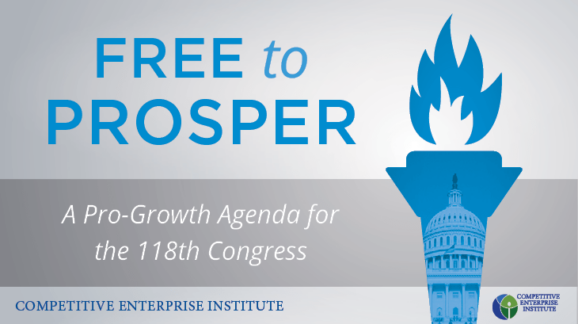Free to Prosper: Inflation
In 2022, inflation reached its highest levels in 40 years and became a hot-button economic issue. Confusion surrounding the causes of inflation has resulted in confusing responses from both parties. Inflation is exclusively a monetary phenomenon. When the money supply grows faster than real economic output, inflation results. The larger the gap, the faster the inflation rate. If it’s not monetary, it’s not inflation. Price increases due to supply shocks, foreign wars, or other factors are not inflation. That doesn’t mean those issues don’t deserve policy makers’ attention. It just means they are not inflation and should not be confused as such.
In the United States, the Federal Reserve controls monetary policy, which means the bulk of responsibility for inflation is on the Fed.
That is inconvenient for Republicans, who want to blame President Biden for inflation. It is equally inconvenient for Democrats, many of whom want to blame corporate greed for inflation. Both should instead look toward the Fed. There are things Congress can do to address inflation in addition to setting up the Fed for success.
Less Spending
In the short to medium term, Congress can help fight inflation by spending less. Deficit spending increases the amount of money circulating in the economy, but often without increasing economic output. New spending projects don’t create new output, but redirect it from other uses. Politically directed activity tends to create less value than entrepreneurial activity, so many government spending projects actually decrease economic output compared to the government doing nothing. The result is a double whammy for inflation—more money chasing less output.
That said, fiscal policy has a much smaller effect on inflation than monetary policy, so it is important not to overstate the inflationary effects of deficit spending, which are modest. Congress’ multiple trillion-dollar COVID-19 spending bills together will likely add roughly a percentage point to inflation for the next several years. As of this writing, inflation is 8.2 percent.
Still, adding a percentage point to inflation makes the Fed’s job harder than it needs to be. When inflation is at a 40-year high and people are feeling the pain, Congress should at least do no harm.
Rule-Based Monetary Policy
In the long run, Congress should help the Fed commit to a rule-based monetary policy. During the Great Moderation that lasted from the early 1990s to 2007, inflation remained low and stable—usually approximately 2 percent. A major reason was that the Fed informally committed itself to a predetermined policy rule: If inflation reaches a certain level, the Fed automatically adjusts the money supply by a matching amount determined by the rule.
When Fed policy makers take a more discretionary approach, the result is often higher and more volatile inflation, with all the economic harm that implies. That was the case during most of the 1960s and 1970s, when inflation was all over the map and peaked at nearly 15 percent.
During most of the Great Moderation, the Fed followed a “Taylor rule,” which focuses on interest rates. There are other possible rules the Fed could adopt that would also work well. The Fed could directly target the money supply or focus on nominal gross domestic product (NGDP). The rule that is chosen is less important than choosing a rule in the first place and committing to it.
Credibly committing to a rule has two major benefits.
One is predictability, which is good for long-term planning and investment. When there is a recession or crisis, policy makers are tempted to use emergency measures and other forms of discretion. That often makes things worse in the short term.
In the long term, it can discourage investment because people become reluctant to make lengthy commitments if they don’t know what the monetary environment will look like the next time a recession hits. Expectations can influence inflation rates. Companies will set prices based on where they think inflation is headed. If they expect inflation to be high, they will increase their prices early and often. A credible Fed policy rule would keep inflation expectations low and stable—and accordingly influence the way companies adjust their prices.
Another benefit of rules is that they help to safeguard the Fed against political interference. President Lyndon Johnson physically intimidated then-Fed Chairman William McChesney Martin at his Texas ranch to convince him to boost inflation to stimulate the economy leading up to the 1968 election. President Richard Nixon made threats against then-Chairman Arthur Burns for similar reasons during his tenure. More recently, Presidents Trump and Biden have also made unsubtle hints about what they would like the Fed to do.
Those tactics worked because the Fed had the discretion to enact those policies. If the Fed was bound by a monetary rule, Fed chairs can simply tell politicians that they do not have the authority to do what they are being asked.
A monetary rule is one way to preserve the Fed’s independence while adding predictability that entrepreneurs and investors can plan around. Congress should help the Fed enact such a rule, whether that rule targets interest rates, the money supply, or NGDP.
